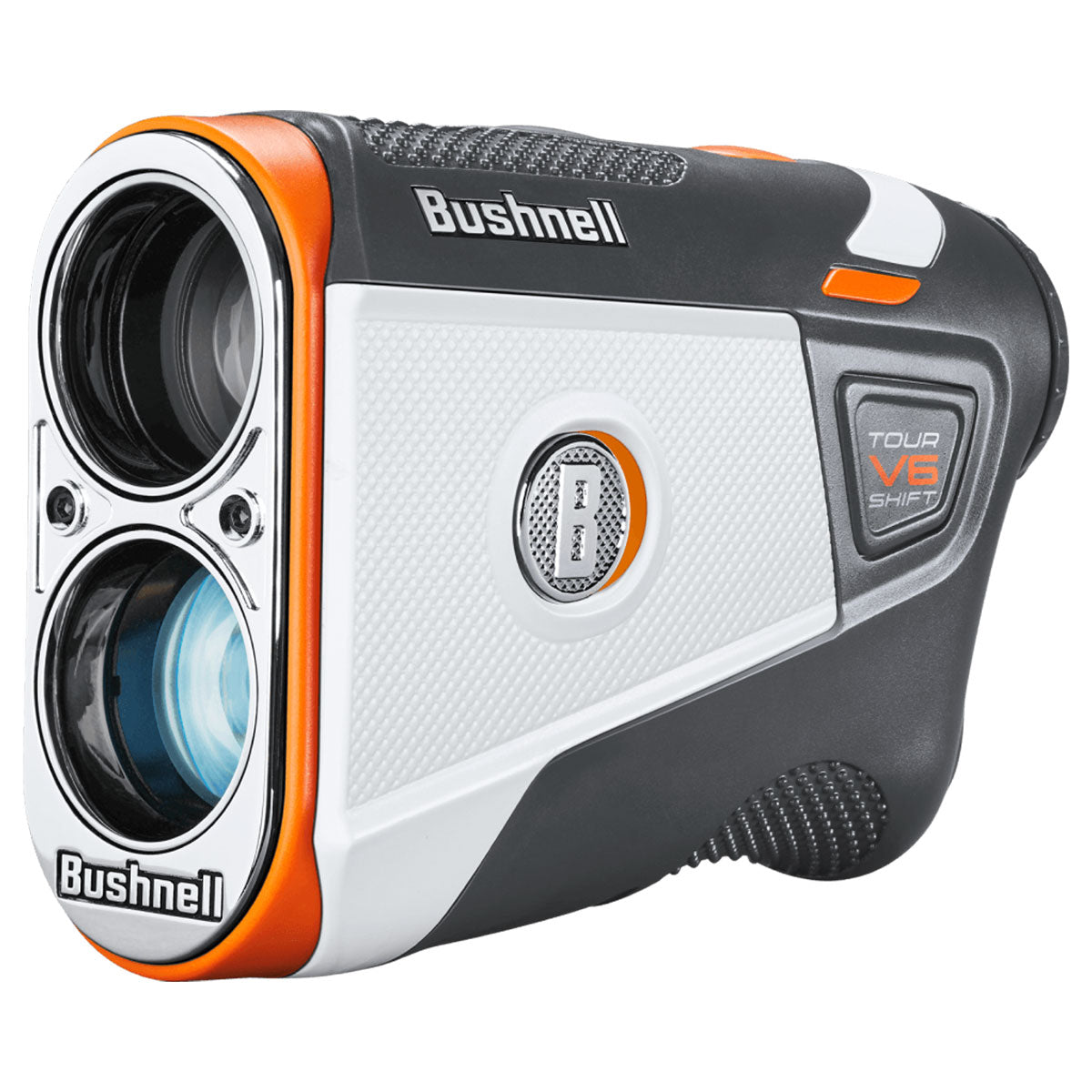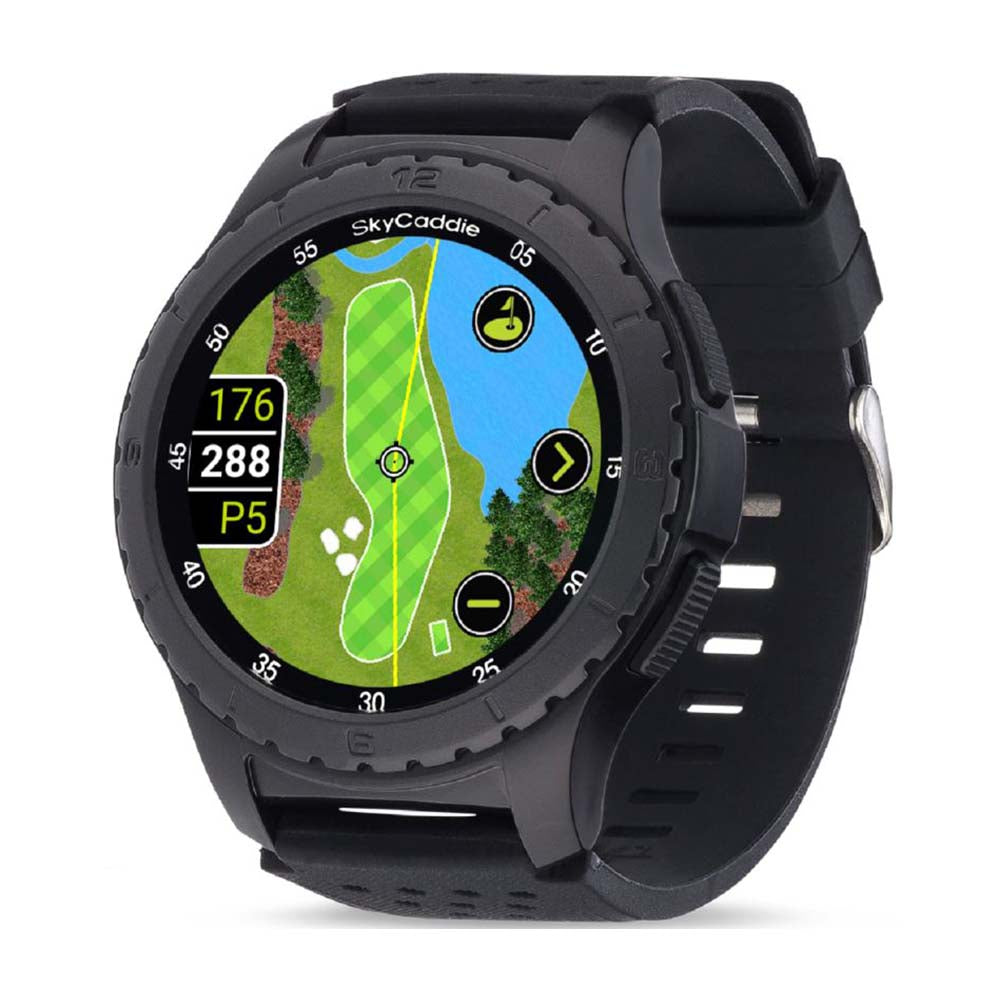
Rangefinder vs GPS: What Is the Best Way To Get Your Distances on the Golf Course?
Golf watch, rangefinder, or GPS handheld ... which will serve you best on the golf course? If you're a tech junkie or want to be prepared for any situation (which this game can certainly serve up on the regular) you might want it all!
It’s wild to think that it really wasn’t that long ago that we were all getting our yardages out on the golf course off of sprinkler heads and blue, white, and red stakes in the ground.
Remember having to count your paces from the 150-yard marker to where your ball was, trying to figure out which club to pull based on whether you’re 160 yards out or 170?
Or maybe you’re still rolling that way. But if that is how you’re playing golf today, you’re behind the times. And you might be costing yourself strokes. Today, there are so many options available to help you get pinpoint, perfectly accurate distance information a lot faster than it takes you to walk to the nearest sprinkler head or pace off yardages.
The problem now is figuring out the best golf distance finder to choose. While there are varying features within each category, you’ve got three overall options: A golf rangefinder, a golf GPS watch, or a handheld golf GPS.
Is one of them better than the others?
That depends entirely on who you ask. The thing about these types of devices is that each includes advantages and disadvantages relative to the others. Choosing the correct device for your game all comes down to finding which benefits best align with your personal preferences and playing style.
But before we can dive into which devices have which advantages and how they compare to each other, let’s make sure we’re solid on our understanding of what each type of device does.
Table of Contents
What Is a Golf Rangefinder?
A golf laser rangefinder works by emitting a laser beam towards a target, such as a flagstick, bunker, or other landmarks on the golf course. When the laser hits the target, it reflects back to the rangefinder. The device then measures the time it takes for the laser to travel to the target and back. Using the speed of light, the rangefinder calculates the distance based on this time interval. It all happens in less than a second.
A golf laser rangefinder with slope will even factor in the elevation incline or decline and give you an adjusted yardage that shows you how much the terrain will affect the distance you have to cover.
While the main function of a rangefinder is getting precise measurements via a laser, some of the best golf rangefinders also incorporate some GPS functionality either in tandem with a phone app or even in the rangefinder’s viewfinder itself.
What Is a Golf Watch?
A golf watch connects to GPS satellites to determine your precise location on the course. The watch uses its database of golf course maps to match your location with the corresponding course layout. Based on your position, the watch calculates distances to various key points on the hole, such as the front, middle, and back of the green and hazards. That information is all displayed on the watch screen for quick access during a round of golf.
Today’s best golf watches go beyond those yardage basics to include additional features like a map of each hole, slope-adjusted distances, the ability to keep score, and even shot-tracking analysis. Some golf watches also work as off-the-course smart watches that have fitness and sleep tracking capabilities, email and text message storage, and an array of other lifestyle features.
What Is a Handheld Golf GPS?
A handheld golf GPS works the same way as a golf GPS watch. The difference, of course, is that you don’t wear it around your wrist. Instead, this type of GPS is small enough to fit in your pocket and pull out when you want quick yardage information. And some GPS units include a built-in magnet so that you can mount it to your cart while you play.
Generally, handheld golf GPS devices are limited to just golf functionality and don’t include the off-the-course features available in some golf watches.
Now that we’ve got a basic understanding of how each type of golf distance finder works, let’s get into how they compare so that you can decide which one best fits your game.
Golf Watch vs Rangefinder
The golf watch vs rangefinder debate typically boils down to speed and convenience vs precision.
A golf watch can deliver yardage information immediately. All you have to do is glance at your wrist.
A golf rangefinder, on the other hand, is more cumbersome because you have to take it out and point it at your target each time you want a distance. But the big advantage is that the distance you do get is going to be pinpoint accurate.
Because only a rangefinder can deliver exact down-to-the-yard distances, it is usually the preferred choice by the best players whose game is precise enough that they require the most specific and accurate information.
But because of the speed and convenience of a golf watch, it is often the better choice for a more casual player who wants general yardage information but isn’t as concerned about that information being specific down to the exact yard.
As some golf watches include things like a map of each hole, they become advantageous in situations where you can’t see your target and therefore can’t shoot the distance with a golf rangefinder. Say you’re blocked out by a tree or hill. With a golf watch, you can get distances to any point on that hole, whether you can see it with your own eyes or not.
And, of course, as some best golf watches include off-the-course features, some golfers prefer them to rangefinders because they are an all-day lifestyle tool.
Golf Rangefinder vs GPS
Most top-level players won’t rely on a handheld golf GPS for the same reasons they won’t use a golf watch as their primary distance device. The best players require the most precise yardage information, which is why they prefer using a golf rangefinder.
Where a handheld golf GPS really shines is in providing super-quick yardage information in a device that you don’t have to wear around your wrist. The other big advantage of a handheld GPS device is that most of them cost much less than most golf rangefinders.
And, just like with a golf watch, a golf GPS gives you the advantage of getting your yardages even when you can’t see your target.
Golf GPS Watch vs Handheld
The primary advantage of a handheld golf GPS over a golf watch is that the handheld device is typically much less expensive.
Of course, the other big advantage is that you don’t have to wear the handheld GPS around your wrist. Not everyone likes the idea of wearing a watch when they swing a golf club.
Beyond those handheld golf GPS advantages, a golf watch will generally outperform a handheld. Golf watches usually come with many more features, including in-depth hole maps so that you can see visually what you’re trying to navigate. The best golf watches even include shot-tracking capabilities and in-depth analysis of your golf game.
Golfers who just want fast front/middle/back distances often find everything they need with an affordable handheld golf GPS. Those golfers who want more than that usually find it worthwhile to invest in a golf GPS watch.
Best Golf Rangefinder Options
We’ve put together a blog post with 22 incredible golf rangefinder options. Each product offers something a little different than the others, and there are significant price differences. The rangefinder you want is definitely somewhere on that list, so be sure to check it out. In the meantime, here are three of our favorites.
Bushnell Pro X3+
Bushnell’s reputation for leading the field in rangefinder technology and build quality is well established, and the Pro X3+ embodies their top-tier innovations. This rangefinder integrates every advancement Bushnell has pioneered, alongside the best features introduced by competitors, making it the ultimate golf laser.
The Pro X3+ includes wind speed and direction, temperature, and barometric pressure measurements. Add in slope-adjusted yardages and impeccable 7x magnification optics, and the Pro X3+ delivers an unparalleled experience. The dual display offers red or black settings, while the Pinseeker technology with visual jolt ensures you never miss your target. Additionally, it boasts a locking slope-switch, home elevation adjustment, and an integrated BITE magnetic mount.
Priced at $599.99, this Bushnell golf rangefinder is an investment in excellence, but it’s the best of 2024.
For more details, check out our comprehensive Pro X3+ review.
Garmin Approach Z30
Priced at $399.99, the Garmin Approach Z30 delivers exceptional value for golfers. The Z30 offers 6x magnification, slope-adjusted yardages, and target lock vibration for precise distance measurements. Its standout feature is the seamless integration with other Garmin devices, creating a comprehensive golfing ecosystem. The Range Relay feature syncs information across devices, providing both pinpoint distances and front/middle/back yardages for an enhanced experience.
With a range of 400 yards, ergonomic design, and reliable performance, the Garmin Approach Z30 is a strong contender in the mid-priced rangefinder category. It’s especially appealing for those already invested in Garmin’s ecosystem.
Read our full Garmin Approach Z30 review to learn more.
Shot Scope PRO LX+
As we’ll discuss below, the ultimate solution is to have both a golf rangefinder and a golf GPS. Each gives you an advantage for certain scenarios. And the Shot Scop PRO LX+ is the perfect device for having the right tool for whatever the situation. It is a golf laser rangefinder with a detachable handheld GPS.
Not only can you measure distances with the PRO LX+’s laser and get front/middle/back yardages via the detachable Shot Scope H4 handheld GPS, but this device even comes with 16 tracking tags, allowing you to gather more than 100 performance stats to analyze and improve your game.
Best Golf GPS Watch Options
The market is seemingly flooded with golf watch options in 2024, but not every choice is a good one. We’ve sorted through it all to give you our 11 golf watches worth owning this year, so be sure to check out that post. Or buy any one of the following three winners with complete confidence.
Garmin Approach S70
If you want the very best golf watch of 2024, one that can do everything any other golf watch can do and a lot that those competitors can’t, you want the Garmin Approach S70. It is the golf watch gold standard.
Combining innovation, features, reliable performance, and style in a way that no other golf watch can match, the S70 includes:
- A super-bright AMOLED touchscreen display
- Maps and yardages from more than 43,000 preloaded golf courses
- Club suggestions based on performance, wind speed, and direction
- A plays-like distance feature that accounts for slope and weather
- 24/7 health monitoring and activity tracking
- A stylish, lightweight build with a ceramic bezel
- And much more
Available in Black, White, or Gray, the S70 is elegantly designed and even suitable for high-end occasions, ensuring you can wear it with pride both on and off the golf course. You can get a 47mm version for $699.99 or a 42mm model for $649.99.
SkyCaddie LX5/LX5C
The SkyCaddie LX5 and LX5C golf GPS watches are renowned for their stunning, high-resolution displays. While they may lack advanced features like shot data, club recommendations, or wind speed and direction, the large screen, multiple brightness options, and crisp resolution ensure you never have to strain your eyes to get your yardages.
The LX5 model, for $249.95 is the more basic option, featuring a simpler, less expensive plastic bezel. The LX5C, at $299.95, offers a touch of luxury with a higher-quality ceramic bezel.
Both versions boast a user-friendly touchscreen that provides a clear overview of each hole. You can swipe, pinch, and drag on the screen to get distances to hazards and layup targets, as well as standard front/middle/back yardages from any location on the hole. On the fitness side, these watches include a step counter and heart rate monitor.
Voice Caddie T9
Voice Caddie revolutionized the market with their accurate heat map and green undulation technology. With the addition of shot and putt tracking in the $349.99 T9 flagship model, they’ve become a strong candidate for the best overall golf watch.
The T9 deserves special recognition for its exceptional shot tracking accuracy, particularly for putts. Unlike other golf yardage watches that require manual entry after each shot, the T9 automates this process, even on the greens.
The T9 also features a swing tempo practice mode, allowing golfers to perfect their rhythm for more consistent shots.
Best Handheld Golf GPS Options
The beauty of a handheld golf GPS is that you don’t have to spend a lot to get a lot. Unless you want all of the advanced features that the best golf watches deliver, or you need the exactness of a laser rangefinder, a handheld will provide you with plenty of useful information without costing you too much. Here are our go-to recommendations.
Bushnell Phantom 3
In an age where golf tech has become increasingly complex, the Bushnell Phantom 3 Slope GPS offers a refreshing return to simplicity. Priced at $149.99, this handheld strikes a perfect balance between essential features and user-friendly design.
The Phantom 3 introduces slope-adjusted distances, a significant upgrade over previous models. The new touchscreen interface is intuitive and displays large, easy-to-read numbers, which is particularly beneficial for golfers with vision challenges.
Despite its simplicity, the Phantom 3 doesn’t skimp on useful features. It includes a robust magnetic cart mount, a shot distance calculator, auto course and hole recognition, auto-prompt score entry, and a round timer with an odometer for tracking fitness.
Check out the Bushnell Phantom 3 review on PlayBetter!
Shot Scope H4
Priced at the same $149.99 point as the Phantom 3, the Shot Scope H4 may not include slope-adjusted yardages, but it does come with shot tracking tags that you can use to keep track of all your golf stats. That’s a tremendous value, especially when you consider that there are no subscription fees.
The H4 is a tiny device that you can comfortably keep in your pocket without interfering with your golf swing at all. You won’t even notice that it’s there.
And as noted earlier, if you want to combine the advantages of a rangefinder and GPS device, the Shot Scope PRO LX+ includes a laser rangefinder with the H4 attached via magnet. You can leave the GPS mounted to the laser, or pull it off and operate the two devices independently.
SkyCaddie PRO 5X
Alright, so at $399.95, this handheld is certainly on the more expensive side. But you get a tremendous return on your investment. The SkyCaddie PRO 5X is the device to choose if you want a beautiful, color, detailed map of every hole. And with a 5.5” vibrant touchscreen, it’s a great option for golfers who don’t want a tiny handheld device.
If you want a fully detailed hole map but don’t want to wear a golf watch, the SkyCaddie PRO 5X might be the choice for you.
Rangefinder vs GPS: Why Not Use Them Both?
If you’re really serious about your game, or if you’re a golf tech junky, you’d be best off with both a golf rangefinder and golf GPS device. That way, you’d be covered in all situations.
There are times during a round of golf where there is no substitute for a golf rangefinder. When you need the exact number to a pin, a rangefinder is the best tool. Or say you want to know how far it is to a specific tree or a little mound in the fairway. A rangefinder is the device that gives you that ability to get exact yardages to very specific targets.
But what about when you’re stuck in the trees? Let’s say you think you’re close enough to the green to reach, but you can’t see the flagstick to shoot a distance with your rangefinder. That’s when a golf watch or GPS handheld comes in handy. Or say you’re facing a blind shot on a hole you’ve never played. With the right kind of golf watch, you’d be able to look at a map of the hole to see where the trouble is that you need to avoid.
The reason that today’s best golf rangefinders are trying to incorporate more GPS functionality is because those manufacturers realize that a rangefinder without GPS doesn’t serve golfers very well in certain situations.
And the reason that today’s best golf watches and best golf GPS devices include features like being able to manually move the pin on the device display to approximate its exact location on the green, is because those manufacturers realize that golfers often need more than the general front/middle/back yardage information that GPS devices otherwise provide.
In other words, in this rangefinder vs GPS debate, neither option is perfect on its own. The best solution of all is to have both.
About PlayBetter Golf Reviewer Marc Sheforgen
Marc Sheforgen is a golf writer whose passion for the game far exceeds his ability to play it well. Marc covers all things golf, from product reviews and equipment recommendations to event coverage and tournament analysis. When he’s not playing, watching, or writing about golf, he enjoys traveling (often golf-related), youth sports coaching, volunteering, and record collecting.







































